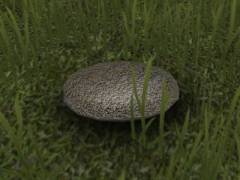
Eder Tsogal
Several factors contribute to the rock's feeling of solidity: the texture, the faint highlight, the blades of grass obscured behind it. But the most dramatic is the dark shadow underneath.
This is not a dynamically generated shadow. (In fact, I took these images with the client's shadow option turned off.) The dark effect is right in the polygons -- darkest underneath the rock, fading away from it.
Painted-on shadows aren't limited to small rocks. Taller rocks, of course, shadow their own back faces as well as the ground underneath:
And a somewhat larger rock will have a somewhat larger shadows:
Again, this dark effect is simply painted onto the landscape. But it enormously aids the sense of the volcano's presence.
Tall objects cast long shadows, of course; and you have to know where the light is coming from. But even small objects will have a bit of darkness underneath. Look back at that first rock. The shadow isn't really about the direction of the sunlight. It would work as well in a cloudy Age, or indoors. We always feel that diffuse light is coming from above, so a diffuse shadow underneath is always appropriate.
In fact, diffuse shadows are appropriate in any narrow space. Look at these stairs:
The recessed corners of the treads are dark. (And the protruding corners are bright -- particularly on top.) This does more to convey the shape of the stairs than any other feature of the model.
Many, many of the "narrow corners" in Uru have this sort of shadow effect. Look at this scene:
Shadows lie just about everywhere that two planes form a reverse angle. The inside corners of the stair treads; the base of the wall; the sides of the wall buttress. It's a trick which, I think, will never go wrong for you.